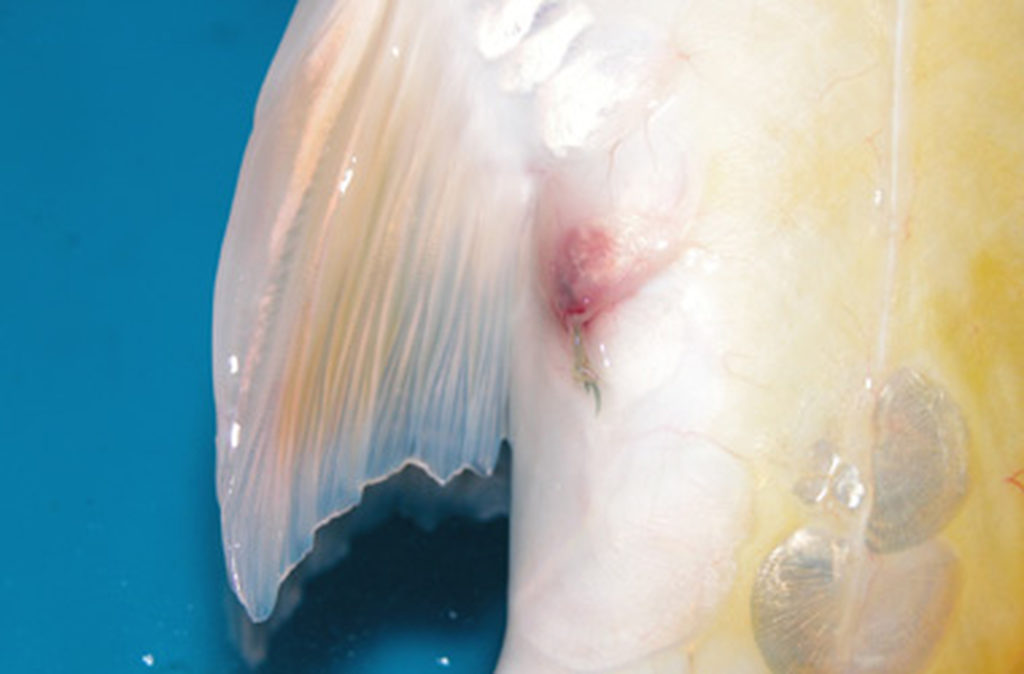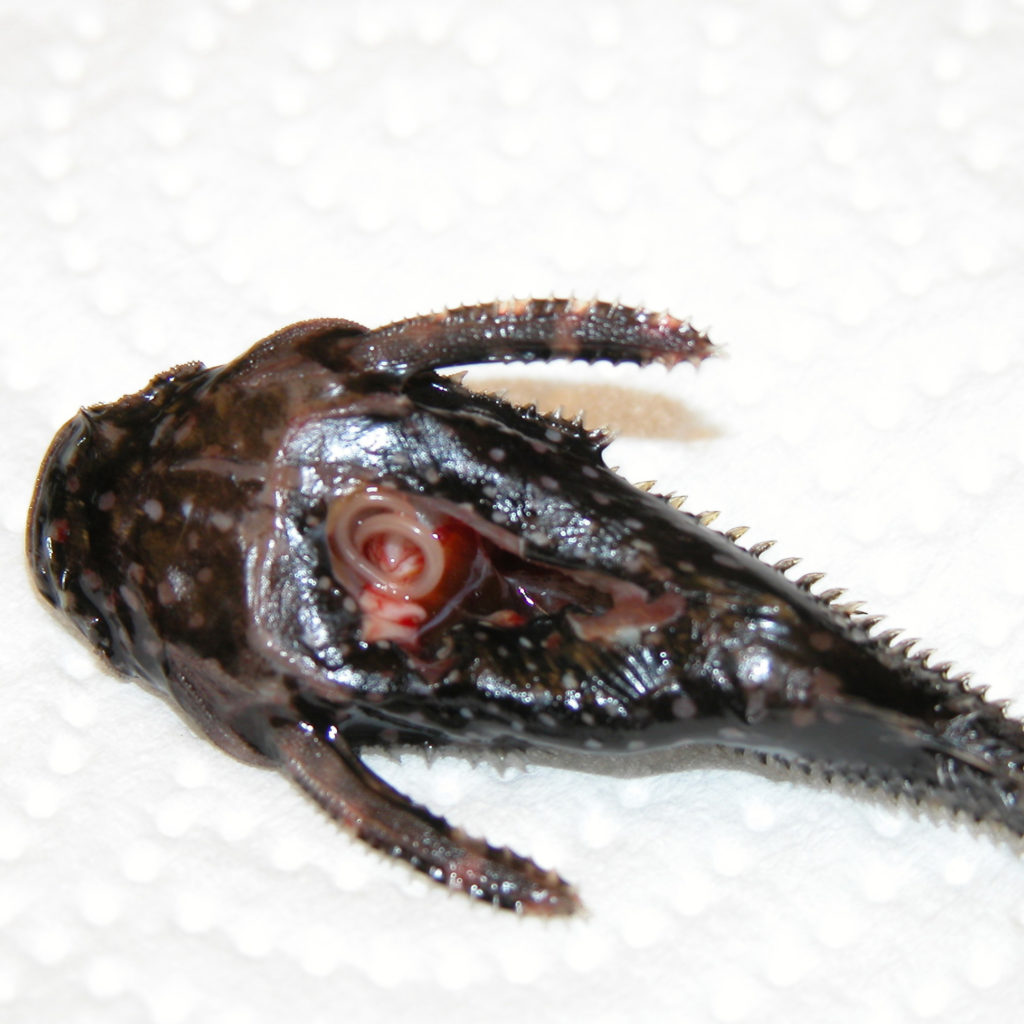Milling headworm in ornamental fish: In another part of the best known and most widespread fish diseases, let's face it today milling headworm dedicate. This type of disease is one of many among the special ones worm diseases. There are many more such as hookworms, roundworms (nematodes), Lernaea, anchor worms, stick crabs or fish leeches. Most of these worm diseases can be controlled in a very similar way. This guide is primarily about the milling headworms go, because these are very easy to determine, especially as far as recognition is concerned.
Milling headworm symptoms and recognition
First, let's take a look at the external characteristics of these parasites. You usually discover this when you look at the After the ornamental fish takes a closer look. Therefore, we always recommend a close observation of the ornamental fish, what to do care plan should include, because this is the only way to detect fish diseases early on. Red-brown threads that already look like worms come out of the anus of the fish. The anus is very red. The fish often eat badly days beforehand and already look very emaciated. In addition, the anus is also very wide open. The first symptoms can also be seen in the excretions of the fish, because the faeces are very white and slimy. In addition, it can also happen that the abdominal cavity inflates significantly.
In addition to the external symptoms, there are also certain behavioral problems. These are usually a loss of appetite and also a rather sluggish swimming behavior. Of course, there are also certain symptoms inside the fish, because that is where the milling head worms have spread through the intestines. This is usually only discovered after an autopsy. You should be able to see this pretty well in the attached pictures.

- Emaciated fish
- Don't feel hungry - don't eat
- Red-brown worms from the anus
- Red anus
- Wide open anus
- white feces
- Bloated body of the ornamental fish
Perhaps a word about which ornamental fish are particularly often affected by milling head worms. Basically, you can't name a special breed or genus here, because next to that Scalar, can also be a discus, a guppy or one catfish be affected by this disease. However, they are mostly found in cichlids and cichlids. As always, it is important to recognize and treat it quickly.
Incidentally, milling head worms are up to 2 cm long.
- Against hairworms, pinworms, milling head worms and other nematodes.
- For internal bacterial infestation for freshwater and saltwater fish.
- Against re-infestation: Due to the life cycle of the pathogen, multiple doses are required. Pathogens detach from the fish after a few days and sink to the bottom.
- JBL online hospital: access to the detection of fish diseases.
- Scope of delivery: 1 pack 10074 JBL Nedol Plus 250, 100 ml. Suitable for aquariums max. 750 l. With repeated use for max. 250 l. Application: 10ml/40L aquarium. Duration of treatment: approx. 2-3 days, 1./21. or 1st/10th/20th day = 2-3 doses
Causes of Milling Head Worms
Of course we also have to Causes because this should always be the first step in detecting a disease. This is the only way to achieve sustainable success.
Basically, the worms are usually dragged into the aquarium by host animals. These are mainly found in live food. Be it Artemia or other types of live food such as Tubifex or mosquito larvae.
However, there is also a genus of milling head worms (Camallanus) which is viviparous and can therefore spread over several generations of ornamental fish without a change of host. This genus belongs to the roundworms.

What do the milling head worms do in the intestine?
As the name suggests, the milling head worms eat into the intestines. They bite into their intestines and pierce them with it. They suck the blood from these places, which they use as food. If they no longer have any blood available, they take a new place in the intestines, which causes more and more holes in the fish and its intestinal tract.
Treatment and control of milling headworms
Here, too, there are various active ingredients that have already had many successes in practice. But be careful when using them, because most preparations are deadly against mussels, shrimp or snails. Therefore, the fish should be separated during treatment.
Sufficient oxygen should also be provided during treatment. The best way to do that is with one diaphragm pump. Also is the Water change an integral part of the treatment.
As always after one drug treatment should then be filtered over activated carbon for 24 hours to get the residues out of the water. Disinfection may also be necessary.
The exact dosage can be found in the respective package insert of the manufacturer. We can here the preparation of JBL Nedol Plus 250 recommend, which in addition to the milling head worms also has an effect on hairworms, pinworms and other nematodes.
The active ingredients of the drugs are mainly Concurat, Levamisole or Flubenol. With these drugs and early detection, you can usually achieve very good results. source images jbl.de
- Against hairworms, pinworms, milling head worms and other nematodes.
- For internal bacterial infestation for freshwater and saltwater fish.
- Against re-infestation: Due to the life cycle of the pathogen, multiple doses are required. Pathogens detach from the fish after a few days and sink to the bottom.
- JBL online hospital: access to the detection of fish diseases.
- Scope of delivery: 1 pack 10074 JBL Nedol Plus 250, 100 ml. Suitable for aquariums max. 750 l. With repeated use for max. 250 l. Application: 10ml/40L aquarium. Duration of treatment: approx. 2-3 days, 1./21. or 1st/10th/20th day = 2-3 doses


